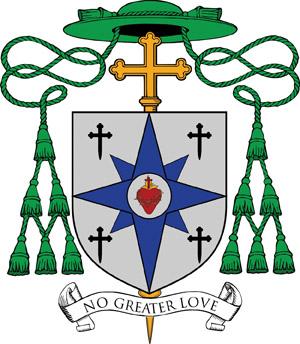
By Bishop Robert Gruss
In designing the shield — the central element in what is formally called the heraldic achievement — a bishop has an opportunity to depict symbolically various aspects of his own life and heritage, and to highlight particular aspects of Catholic faith and devotion that are important to him.
Every coat of arms also includes external elements that identify the rank of the bearer. The formal description of a coat of arms, known as the blazon, uses a technical language, derived from medieval French and English terms, which allows the appearance and position of each element in the achievement to be recorded precisely.
A diocesan bishop shows his commitment to the flock he shepherds by combining his personal coat of arms with that of the diocese, in a technique known as impaling. The shield is divided in half along the pale or central vertical line. The arms of the diocese appear on the dexter side — that is, on the side of the shield to the viewer’s left, which would cover the right side (in Latin, dextera) of the person carrying the shield. The arms of the bishop are on the sinister side — the bearer’s left, the viewer’s right. (What you see here is my coat of arms and not the impaled version.)
My coat of arms is dominated by a cross estoile, a star-shaped cross that also resembles a compass rose. It alludes both to my former occupation as a commercial pilot, as well as to my responsibility as a priest and bishop to lead the people entrusted to my care along the straight and narrow Way that leads to eternal life (cf. Matthew 7:14). Surrounding the compass are four small crosses painted black (sable); their particular shape and depiction on a silver (argent) background recalls the coat of arms of the Diocese of Davenport, where I spent 30 years of my life and which I served as a priest for 17 years. On a silver disc at the center of the compass is a depiction of the Sacred Heart of Jesus. I served as rector of Sacred Heart Cathedral in Davenport from July 2010 until my appointment as Bishop of Rapid City.
The compass is painted blue (azure) to allude to Our Lady, whose vocation, like that of mine, is to point the way to the heart of her Son. Thus the Sacred Heart — such a precious symbol of Our Lord’s human nature — is placed within the compass, as it first grew within the womb of the Virgin Mary. The white disc (plate) behind it recalls the sacred Host, and makes the cross estoile resemble not only a compass but also a monstrance, recalling the centrality of the Eucharist in the life of the priest and the life of the Church.
This mystery of the Lord’s sacred humanity and of his infinite love, “even unto death” (Philippians 2:8), is central not only to my coat of arms, but to my identity and ministry as a priest and a bishop. The responsibility to love and to sacrifice in imitation of Jesus Christ is further recalled in the motto inscribed on the scroll below the shield. The phrase is taken from the words of the Lord to his apostles at the Last Supper: “There is no greater love than to lay down one’s life for one’s friends” (John 15:13).
The shield is ensigned with external elements that identify the bearer as a bishop. A gold processional cross appears behind the shield. The galero or “pilgrim’s hat” is used heraldically in various colors and with specific numbers of tassels to indicate the rank of a bearer of a coat of arms. A bishop uses a green galero with three rows of green tassels.








